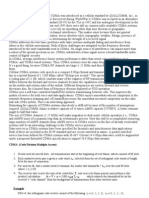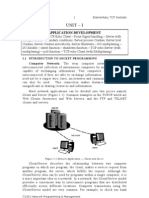1.1 Brief History:: RTTC/HYD/TD/BSNL/Industrial Training On Telecom Technologies-Advanced/V1/R0 DATED 2-8-2012
Uploaded by
KrishnaRebelz1.1 Brief History:: RTTC/HYD/TD/BSNL/Industrial Training On Telecom Technologies-Advanced/V1/R0 DATED 2-8-2012
Uploaded by
KrishnaRebelzRTTC/HYD/TD/BSNL/Industrial Training on Telecom Technologies-Advanced/V1/R0 DATED 2-8-2012
CDMA
1.1 Brief History:
In mid 1980s, the second-generation cellular mobile communication system featuring TDMA,
CDMA and digital modulation (QPSK, /4-QPSK and GMSK) appeared. The major modes in
this phase include GSM of Europe, DAMPS of the US and the CDMA system put forward by
Qualcomm of the US. At that time, since some critical techniques in the CDMA system were
not properly solved, the development of the CDMA technology was relatively slow. However,
since the GSM system adopted the TDMA technology, which was mature at that time, the
utilization of frequency spectrum was increased, and the shortcomings of the analog system
were well solved. Therefore it gained wide support from telecom operators and equipment
manufacturers of the world, and the globally united GSM system standard was made up.
However, for the very reason that this kind system used the TDMA mode, the anti-
interference and anti-attenuation capability of this kind of system was still unsatisfactory,
certain protection time slots were required, and the system capacity was unable to meet the
growing requirements of the users. Besides, the design of this kind of system is very
complicated, the frequency utilization was not high, and the hard handoff mode was adopted
for inter-cell handoff, which tended to cause call drops, and was unable to satisfy the users
growing fast data transmission and broadband video multimedia service requirements.
Nevertheless, since the CDMA technology involves multiple critical technologies, it has many
unique performances, which largely increases the system capacity (analyses show that its
system capacity is ten times that of FDMA, and over four times that of TDMA), and it does
not require protection bands and timeslots. The CDMA technology itself has provided the
basis for the realization of soft handoff and software capacity. Further more, the frequency
classification in the CDMA system has become relatively simpler, and its anti-interference
and anti-attenuation capabilities are also better the former two ones. In a word, the overall
performances of the CDMA cellular mobile communication system are all superior to those of
all the other currently existing cellular mobile communication systems.
RTTC/HYD/TD/BSNL/Industrial Training on Telecom Technologies-Advanced/V1/R0 DATED 2-8-2012
RTTC/HYD/TD/BSNL/Industrial Training on Telecom Technologies-Advanced/V1/R0 DATED 2-8-2012
It is because CDMA has the all the above-mentioned merits, and it is more because
Qualcomm has solved some of the critical technologies, that the CDMA has attracted
extensive attention from the worlds telecom businesses, which makes all believe that
CDMA is the most prospective communication technology in the future wireless
technology development, thus making it an outstanding one among the digital cellular
mobile communication systems. The development of CDMA has been a progressive
process, and the commercial products on the current market are basically all based on
the IS-95A narrow-band N-CDMA technology. It is presently the development direction
of CDMA to realize low-cost, high-quality, inter-connective and inter-working, and IP-
supporting and data-supporting services and wireless intelligent network (WIN)
services, aiming at providing users with convenient and effective communication
services, on the basis on the existing narrow-band N-CDMA. From the point of view of
the communication technologies and peoples requirements, the future wireless
communication world will be a broadband, comprehensive data and multimedia
network. The broadband CDMA technology will be an import pillar supporting this
network.
1.2 Basic concepts of CDMA wireless transmission system
Wireless multiple access communication
As we all know, it is a primary issue that must be considered in any transmission system how
to establish channel links among subscribers within the network in the radio wave coverage
area in the environment of wireless communication. In fact, the essence of this question is a
question of multiple address mobile communication. The wireless multiple access modes
currently in use include: FDMA in analog systems, and TDMA and CDMA in digital systems.
The theoretical basis for the realization of multiple access connections is the signal division
technology. That is, suitable signal design is made at the transmitting end so that the signals
sent from different stations are different; the receiving end has the signal identifying
capability, and can choose the corresponding signal from mixed signals.
When multiple access mobile communication is established based on the difference of carrier
frequencies of the transmission functions, the multiple access mode is called Frequency
Division Multiple Access (FDMA); when multiple access mobile communication is established
based on the difference of signal existence time, it is called Time Division Multiple Access
(TDMA) mode; when the multiple access mobile communication is established based on the
difference of transmission signal code forms, it is called Code Division Multiple Access
(CDMA) mode. Fig. 1-2 gives a schematic diagram of the time domains and frequency
domains of FDMA, TDMA and CDMA transmission processes.
RTTC/HYD/TD/BSNL/Industrial Training on Telecom Technologies-Advanced/V1/R0 DATED 2-8-2012
RTTC/HYD/TD/BSNL/Industrial Training on Telecom Technologies-Advanced/V1/R0 DATED 2-8-2012
Fig. 1-2 Schematic diagram of time domains and frequency domains of FDMA, TDMA and CDMA
1.3 Concept of CDMA
The so-called CDMA refers to such a technology that the transmitting end modulates the
signals that it sends using mutually different and (quasi) orthogonal pseudo-random address
codes, and the receiving end detects the corresponding signals by demodulating the mixed
signals using the same pseudo-random address codes.
Concept of spread spectrum communication
A spread spectrum technology is adopted in CDMA transmission systems. The so-called
spread spectrum technology refers to such a technology that the original signals are
converted to transmission signals with much wider bandwidth the original, so as to achieve
the anti-interference purpose of the communication system. Its mathematic model is the
Shanon equation in the information theory. That is, under the condition of noise interference,
the channel capacity is:
C = B log2 (1 + S / N)
Where, B is the channel bandwidth, S is the average signal power, N is the average noise
power, and C is the channel capacity.
From the above equation, we can see: when S/N decreases, the purpose of high quality
communication can be achieved without reducing the system capacity, as long as the
bandwidth B is increased.
Technical features of CDMA
Based on the above analysis, it can be deduced that CDMA has the following technical
features:
1. Invisibility and security;
2. Strong anti-interference and anti-multi-path ability;
3. Realization of multiple access technology, increase of capacity and improvement of
frequency reuse pattern;
4. Wide frequency band seizure, increased system complicity and high synchronization
requirement.
1.4 Principle of CDMA transmission system
CDMA wireless transmission system structure
In CDMA communication systems, the pseudo random address codes are periodic code
series with strong self-correlation but 0 or very small mutual correlation. Based on the
different signal modulation modes, CDMA systems can be divided into DS-CDMA system
and MC-CDMA system.
In a commercial CDMA cellular mobile communication system, CDMA is mainly combined
with the direct spreading technology to form the DS-CDMA system. The systems
transmission in both forward and backward directions is sketched in Fig. 1-3.
RTTC/HYD/TD/BSNL/Industrial Training on Telecom Technologies-Advanced/V1/R0 DATED 2-8-2012
RTTC/HYD/TD/BSNL/Industrial Training on Telecom Technologies-Advanced/V1/R0 DATED 2-8-2012
Cell decoding
Cell coding
Channel coding
Carrier Carrier Cell decoding (de-
(spread spectrum) modulation demodulation spread spectrum)
Walsh code Walsh code
Forward transmission Forward reception
Cell decoding
Cell decoding (de- Carrier
Cell coding
spread spectrum) demodulation Carrier Channel coding
modulation (spread spectrum)
PN pseudo-random code PN pseudo-random code
Backward reception Backward transmission
Fig. 1-3 Sketch of forward and backward transmission and receiving in CDMA transmission system
1.2.5.2 Communication Standards for CDMA Wireless Transmission System
The main standards used in the CDM process are as follows:
1. Either in forward or backward direction, the signals have to be pre-coded first, and
corresponding decoding processing is to be performed in the respective receiving
process;
2. Frequency division duplex (FDD) mode is adopted as the transmission mode;
3. Qualcom variable rate code-excited linear prediction (Q-CELP) mode is used for voice
coding;
4. The convolution coding and block interleaving combination mode is adopted for channel
error correction;
5. QPSK is adopted for forward modulation, and /4-QPSK is adopted for backward
modulation;
6. The spread spectrum signal rate is 1.2288Mbit/s;
7. Frequency bands: 824-849MHz (backward channels/BS receiving), 869-894MHz (forward
channels/BS transmission);
8. Carrier separation: 1.25MHz.
RTTC/HYD/TD/BSNL/Industrial Training on Telecom Technologies-Advanced/V1/R0 DATED 2-8-2012
You might also like
- Sage X3 - User Guide - HTG-Setting Up A Workflow For A Batch Task PDFNo ratings yetSage X3 - User Guide - HTG-Setting Up A Workflow For A Batch Task PDF8 pages
- Enhancement Techniques in Recent Cdma TechnologyNo ratings yetEnhancement Techniques in Recent Cdma Technology8 pages
- Singnal Encoding and Decoding Using CDMA TechniqueNo ratings yetSingnal Encoding and Decoding Using CDMA Technique63 pages
- CDMA-DSS I 01 200904 Principle of Telecommunication-37No ratings yetCDMA-DSS I 01 200904 Principle of Telecommunication-3737 pages
- Cdma - Ofdm - Mc-Cdma-Principles-Merits-DemeritsNo ratings yetCdma - Ofdm - Mc-Cdma-Principles-Merits-Demerits17 pages
- CDMA (IS-95,99) : CDMA (Code Division Multiple Access)No ratings yetCDMA (IS-95,99) : CDMA (Code Division Multiple Access)4 pages
- Cdma:: Code Division Multiple Access (CDMA) Is A Channel Access Method Used byNo ratings yetCdma:: Code Division Multiple Access (CDMA) Is A Channel Access Method Used by10 pages
- Implementation of Cdma Technology in Cellular PhonesNo ratings yetImplementation of Cdma Technology in Cellular Phones13 pages
- Principles of The WCDMA System: InternalNo ratings yetPrinciples of The WCDMA System: Internal46 pages
- Cdma Technology: Patel Bharvi A. (D10560) 4 SEM. (E.C.) Govt - Engg.College GandhinagarNo ratings yetCdma Technology: Patel Bharvi A. (D10560) 4 SEM. (E.C.) Govt - Engg.College Gandhinagar18 pages
- Prepared By: Sapan M. Raval (6 I.T.) Rishin S. Kumar (6 I.T.) C.U.Shah College of Engg. & Tech. Wadhwan CityNo ratings yetPrepared By: Sapan M. Raval (6 I.T.) Rishin S. Kumar (6 I.T.) C.U.Shah College of Engg. & Tech. Wadhwan City31 pages
- 05-Basic Principles of Mobile CommunicationsNo ratings yet05-Basic Principles of Mobile Communications37 pages
- Introduction To Cdma: Code Division Multiple Access (CDMA) Is A Radically New Concept in WirelessNo ratings yetIntroduction To Cdma: Code Division Multiple Access (CDMA) Is A Radically New Concept in Wireless24 pages
- Industrial Training Report On CDMA Technology100% (6)Industrial Training Report On CDMA Technology9 pages
- Module 3: Wireless & Cellular Communication-18EC81: Dr. Asha K, Dept. of ECE100% (1)Module 3: Wireless & Cellular Communication-18EC81: Dr. Asha K, Dept. of ECE49 pages
- W-Cdma: Network and Internet TechnologiesNo ratings yetW-Cdma: Network and Internet Technologies9 pages
- Wireless & Cellular Communication-18EC81: Prof - Priyanka L JCET Hubli ECE100% (1)Wireless & Cellular Communication-18EC81: Prof - Priyanka L JCET Hubli ECE49 pages
- Shortest Path Forwarding Using OpenFlow PDFNo ratings yetShortest Path Forwarding Using OpenFlow PDF58 pages
- Programmer Competency Matrix - Sijin JosephNo ratings yetProgrammer Competency Matrix - Sijin Joseph21 pages
- Swiss-US Privacy Shield Rollout What To Expect - Privacy Insight Series WebinarNo ratings yetSwiss-US Privacy Shield Rollout What To Expect - Privacy Insight Series Webinar22 pages
- Comedk Quick Guide: Important Dates Documents RequiredNo ratings yetComedk Quick Guide: Important Dates Documents Required1 page
- Towards A Contemporary Vernacular Building Envelope - Eindhoven University of Technology Research PortalNo ratings yetTowards A Contemporary Vernacular Building Envelope - Eindhoven University of Technology Research Portal1 page
- OXE Installation On VMware 8 - Complete - Procedure100% (3)OXE Installation On VMware 8 - Complete - Procedure71 pages
- Changing Attitude of Indian Consumer Towards Online ShoppingNo ratings yetChanging Attitude of Indian Consumer Towards Online Shopping36 pages
- Innovative Distribution Channels and Integrating Multi-ChannelsNo ratings yetInnovative Distribution Channels and Integrating Multi-Channels21 pages
- Concise Guide to OTN optical transport networksFrom EverandConcise Guide to OTN optical transport networks
- Sage X3 - User Guide - HTG-Setting Up A Workflow For A Batch Task PDFSage X3 - User Guide - HTG-Setting Up A Workflow For A Batch Task PDF
- Singnal Encoding and Decoding Using CDMA TechniqueSingnal Encoding and Decoding Using CDMA Technique
- CDMA-DSS I 01 200904 Principle of Telecommunication-37CDMA-DSS I 01 200904 Principle of Telecommunication-37
- CDMA (IS-95,99) : CDMA (Code Division Multiple Access)CDMA (IS-95,99) : CDMA (Code Division Multiple Access)
- Cdma:: Code Division Multiple Access (CDMA) Is A Channel Access Method Used byCdma:: Code Division Multiple Access (CDMA) Is A Channel Access Method Used by
- Implementation of Cdma Technology in Cellular PhonesImplementation of Cdma Technology in Cellular Phones
- Cdma Technology: Patel Bharvi A. (D10560) 4 SEM. (E.C.) Govt - Engg.College GandhinagarCdma Technology: Patel Bharvi A. (D10560) 4 SEM. (E.C.) Govt - Engg.College Gandhinagar
- Prepared By: Sapan M. Raval (6 I.T.) Rishin S. Kumar (6 I.T.) C.U.Shah College of Engg. & Tech. Wadhwan CityPrepared By: Sapan M. Raval (6 I.T.) Rishin S. Kumar (6 I.T.) C.U.Shah College of Engg. & Tech. Wadhwan City
- Introduction To Cdma: Code Division Multiple Access (CDMA) Is A Radically New Concept in WirelessIntroduction To Cdma: Code Division Multiple Access (CDMA) Is A Radically New Concept in Wireless
- Module 3: Wireless & Cellular Communication-18EC81: Dr. Asha K, Dept. of ECEModule 3: Wireless & Cellular Communication-18EC81: Dr. Asha K, Dept. of ECE
- Wireless & Cellular Communication-18EC81: Prof - Priyanka L JCET Hubli ECEWireless & Cellular Communication-18EC81: Prof - Priyanka L JCET Hubli ECE
- Swiss-US Privacy Shield Rollout What To Expect - Privacy Insight Series WebinarSwiss-US Privacy Shield Rollout What To Expect - Privacy Insight Series Webinar
- Comedk Quick Guide: Important Dates Documents RequiredComedk Quick Guide: Important Dates Documents Required
- Towards A Contemporary Vernacular Building Envelope - Eindhoven University of Technology Research PortalTowards A Contemporary Vernacular Building Envelope - Eindhoven University of Technology Research Portal
- OXE Installation On VMware 8 - Complete - ProcedureOXE Installation On VMware 8 - Complete - Procedure
- Changing Attitude of Indian Consumer Towards Online ShoppingChanging Attitude of Indian Consumer Towards Online Shopping
- Innovative Distribution Channels and Integrating Multi-ChannelsInnovative Distribution Channels and Integrating Multi-Channels

























































































